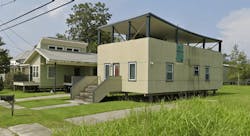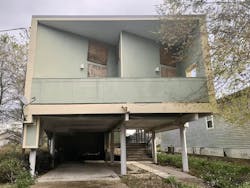The Wrongs of Make It Right in New Orleans' Affordable Housing
In 2011, I visited New Orleans’ Lower Ninth Ward to report on a much-ballyhooed effort to build affordable, resource-efficient, hurricane-resilient new homes for families displaced by Hurricane Katrina in 2005.
The rebuilding project was the inauguration of Make It Right (MIR), a charitable foundation launched by actor and part-time New Orleans resident Brad Pitt, born of his frustration with local authorities that were slow to rebuild a predominantly Black, low-income section of the city.
MIR recruited a team of all-star (if not necessarily housing) architects, headed by Cradle to Cradle guru William McDonough, to envision 150 homes priced below cost, offered first to displaced Lower Ninth residents to encourage their return, and designed—if ultimately in odd, modern shapes and bright colors—to weather future high-water events ... including (no lie) a “floating” home.
I asked, rhetorically, if MIR was 'a real-world application or a promotional aberration.' Turns out it was the latter.
In my article, I asked, rhetorically, if MIR was “a real-world application or a promotional aberration,” and then portrayed it as a model for future public-private housing development partnerships.
Turns out it was the latter. By 2016, the leadership that spearheaded MIR’s work in the Lower Ninth (and elsewhere since) was gone, and claims of catastrophic failures from ill-conceived designs and poor construction among the 109 completed homes there were being levied, some leading to lawsuits against the nonprofit, more often leaving residents to fend for themselves ... again. (This past August, MIR was ordered to pay $20.5 million, about $25,000 per resident, to help cover the cost of repairs to its homes.)
The lessons of Make It Right are obvious, namely that architecture and materials for a given region and its climate matter, and that there are well-founded reasons why and with what homes are built a certain way—nonporous claddings, roofs that shed rainwater, gutters, stuff like that. And if you’re new to a market and its design and building traditions, it would be smart to follow the guidance of those steeped in it before you turn the first shovel of dirt.
It’s also wise to check your ego at the door and focus on building the best homes possible. I’m all for innovations that are thoughtfully and properly applied, but that clearly was not the case in the Lower Ninth.
RELATED
- Disaster Recovery for Home Builders
- The Need for Resilient Construction Is Real. How Are Home Builders Responding?
- New NIBS Report Evaluates Natural Disaster Mitigation Strategies
MIR ignored or neglected those truisms, and the impact on those homeowners was a second kick in the teeth after Katrina. The nonprofit’s failed experiment also cast doubt on the housing industry’s ability to produce affordable, sustainable, and resilient homes—a harmful, lasting legacy.
With its website down, phones off, and offices cleared out, Make It Right now comes off like a cruel joke, failing to fulfill its initial purpose and unable to make it right in the aftermath. Let’s make it our business to Do It Right the first time.
About the Author

Rich Binsacca, Head of Content
Rich Binsacca is Head of Content of Pro Builder and Custom Builder media brands. He has reported and written about all aspects of the housing industry since 1987 and most recently was editor-in-chief of Pro Builder Media. [email protected]

